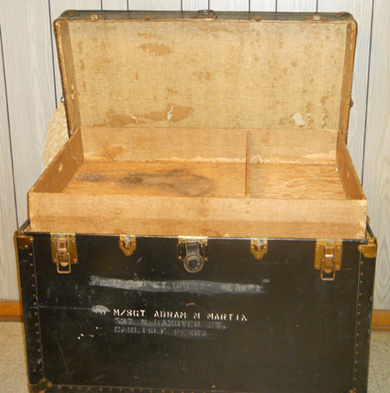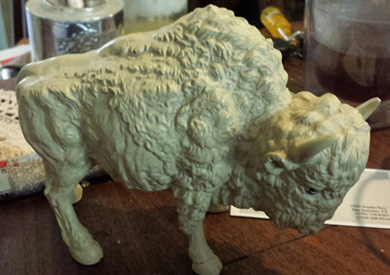 |
|
|||
 |
 |
|||
RINKER ON COLLECTIBLES — Column #1443 Copyright © Harry Rinker, LLC 2014
Questions
and Answers
QUESTION: I own a World War II Army trunk that belonged to M/SGT Airman M. Martin. The truck is 42 inches long, 24 inches deep, and 26 inches high. It has a removable tray. An airway bill (AAF Form 95B, approved August 12, 1942) is attached to the trunk. Overall it is in good condition. The latch is broken; the part is present. What is its value? – PL, State College, PA, Email Question ANSWER: Your trunk has family and/or emotional value. It has minimal collector, decorator, or reuse value. WWII military trunks are extremely common. When sold at auction, they often bring less than $25.00. A price in excess of $50.00 falls in the miracle class. Having stated this, there are methods to enhance the value of the trunk. If M/SGT Airman M. Martin was a member of your family and you have a photograph of him in his military uniform, a WWII reenactor is a perspective buyer. Military reenactors gain points by using objects associated with an individual involved with the war that they are reenacting.
If you have other items associated with the individual such as a uniform (especially if it still has the insignias, ribbons, and medals), personal documents (from family correspondence to a bible), and accoutrements, the value increases further. It is common practice in the antiques and collectibles trade to split groups of objects apart to increase the secondary market financial potential. This does not apply to military material – the bigger the pile, the higher the price. Each additional piece enhances the value of the items that already are part of the collection. When cleaning out an attic or storage area containing WWII material, look for written correspondence to and from a member of the military or a civilian performing wartime services overseas. WWII correspondence is hot. While content does contribute to value, even letters containing the most prosaic and mundane scribbling have value. QUESTION: I am a picker in central Texas. I purchased a Red Mill buffalo mold in a thrift store about six years ago. The mold is marked #403 on the bottom. Red Mill Mfg. went out of business in 2001. Most of the company’s molds were sent to China. Do I have something unusual? – KW, Morgan’s Point Resort, TX, E-mail Question
ANSWER: Red Mill Manufacturing used crushed pecan shells and glue to mold three-dimensional figurines. Animals included a beaver, eagle, horse, turkey, and wolf. Human figures range from cowboys and Indians to children. When an object was removed from the mold, employees lacquered the object to increase its color and depth. Because handwork was involved, Red Mill Manufacturing touted the individual characteristics of each piece. Workers also signed and dated many of the pieces, adding a false value allure to the finished product. A foil sticker also identified the products. Red Mill Manufacturing was located in Fisherville, Virginia, when it ceased operations in 2001, due in part to the death of one of its owners. The key question is not the scarcity of your mold but whether anyone cares. The answer is a questionable no. A recent eBay check showed 305 Red Mill items listed. Asking prices ranged between $10.00 and $20.00. Of course, there always is one optimist. A seller listed a 1987 grizzly bear at a “Buy It Now” price of $49.95. Another eBay seller offered an example of a buffalo made from your mold for a “Buy It Now” price of $29.99. Scarcity is only one element in determining the worth of an object. Demand/Desirability is far more important. A Red Mill collector, provided you can find one, might pay between $40.00 and $50.00 for the mold. One final thought: The “403” is the mold number. However, there is no guarantee that this is the only “403” mold. Molds have a limited life. It is common to have multiple molds when manufacturing objects. QUESTION: Recently, I purchased a Playskool Orange Blossom Special in its period box. I paid $50.00. What are your thoughts about its long-term collectability? – W, Bristol, TN ANSWER: Lucille King established the Playskool Institute as a division of the John Schroeder Lumber Company in Milwaukee, Wisconsin in 1928. The company produced wooden toys for use in the classroom. The Playskool Institute changed hands several times. In 1940, Manuel Fink and Robert Meythaler bought the brand and created the Playskool Manufacturing Company. J. L. Wright, the maker of Lincoln Logs, became part of Playskool Manufacturing Company in 1942. Playskool and Hogate Toys merged in 1958. Halsam Company, a maker of construction sets, wooden blocks, and other toys, was absorbed in 1962. Milton Bradley bought Playskool in 1968, only to be acquired by Hasboro, Inc. in 1984. Hasbro immediately rebranded many of its preschool and early childhood toys, such as Play-Doh and Tonka with the Playskool trademark. Your Playskool Orange Blossom Special dates from the Hasbro era. [For more information see: http://en.wikipedia.org/wiki/Playskool] Bob and Marilyn Chandler of St. Louis, using a real Ford 5-250 4x4 160 powered pickup truck as a prototype, created the design for the Playskoo1 Bigfoot 4x4x4 SST. Introduced in 1985, the Playskool truck required four AA batteries. It had a red forward and reverse lever, a yellow lever for 2 wheel drive, 4 wheel drive, and neutral, working headlights, and an ignition key to power an on-off switch. [For more information, see: http://www.inthe80s.com/toys/bigfoot4x4x4sstbyplayskool.shtml] An eBay dealer has a very fine condition Playskool Orange Blossom Special truck, accessory decals, and box listed with a “Buy It Now” price of $125.00. No one is buying. Another eBay dealer is offering an example with the period box with a starting bid of $49.90. No one is bidding. Your questions raised the issue of what are the hot toy decades in the mid-2010s. Assuming that Rinker’s 30-Year Rule [for the first 30 years of anything’s life, all its value is speculative] remains valid, toys from the early 1980s are starting to achieve a stable secondary market. Internet auction prices, especially eBay, show that interest in 1970s and 1980s childhood toys is strong. Do not be deceived by the “Buy It Now” prices. One hundred and twenty-five dollars is excessive. The $50.00 that you paid is not. Some caveats need to be raised. First, it is not clear if the 1980s toy buyers are collectors or individuals who desire to buy back their favorite childhood toy. If the latter, what they are willing to pay skews the secondary market toward the high side. Second, the Playskool Orange Blossom Special truck is geared to a young audience. It is border line between a preschool toy and a young juvenile toy. Preschool toys have limited collectability. Those who collect tend to be the mothers who remember their child playing with the toy as opposed to the children that played with it. Finally, the long-term collectability of the Playskool Orange Blossom truck is questionable. Collector interest will grow in the decade ahead and peak in the late 2020s. By the 2030s, collector interest will fade, vanishing completely by the end of the decade. QUESTION: My neighbor has a stoneware Old Sleepy Eye bowl. She would like to learn about its history and value. – J, Chedoygan, MI ANSWER: Sleepy Eye was a Sioux Indian chief whose reportedly droopy eye gave his name to Sleepy Eye, Minnesota, and one of its leading flour mills. In the early 1900s, Old Sleepy Eye Flour offered four Flemish gray heavy stoneware premiums, decorated in cobalt blue: a straight-sided butter crock, curved salt bowl, stein and vase. The premiums were made by Weir Pottery Co., later to become Monmouth Pottery Co., and finally to emerge as the present-day Western Stoneware Company of Monmouth, Ill. Additional pottery and stoneware pieces were issued. Forms included five sizes of pitchers (4, 5-1/2, 6-1/2, 8, and 9 inches), mugs, steins, sugar bowls and tea tiles (hot plates). Most were cobalt blue on white, but other glaze hues, such as browns, golds, and greens were used. Old Sleepy Eye reproductions are a major concern. The later pitchers, toothpick holder, and sugar bowl are among the reproductions. There is no evidence that your 4 inch high, 6 1/2 inch diameter gray stoneware sugar bowl has been reproduced. Collector interest in Old Sleepy Eye advertising is waning. An example of the bowl owned by your neighbor sold for $409.50 at Morphy Auctions. Adamstown, Pennsylvania in October 2009. This was five years ago. If auctioned today, the bowl would most likely bring less. A realistic secondary market value for your neighbor’s bowl is between $250.00 and $300.00. The Old Sleepy Eye Collectors Club (www.oldsleepyeyecollectors.com), founded in 1976, maintains a website that contains information about the history of Old Sleepy Eye, the organization’s annual convention, classified advertisements, and images of known reproductions. Club membership is heavily based in the Midwest. The 2014 annual convention took place in July in Iowa City, Iowa.Harry L. Rinker welcomes questions from readers about
collectibles, those mass-produced items from the twentieth and twenty-first centuries.
Selected letters will be answered in this column.
Harry cannot provide personal answers.
Photos and other material submitted cannot be
returned.
Send your questions to: Rinker on Collectibles, 5955 Mill
Point Court SE, Kentwood, MI 49512.
You also can e-mail your questions to
harrylrinker@aol.com.
Only e-mails containing a full name and mailing address
will be considered.
You can listen
and participate in
WHATCHA GOT?, Harry’s
antiques and collectibles radio call-in show, on Sunday mornings between 8:00 AM
and 10:00 AM Eastern Time.
If you
cannot find it on a station in your area,
WHATCHA GOT?
streams live on the Internet at www.gcnlive.com.
SELL, KEEP OR TOSS?: HOW TO DOWNSIZE A HOME,
SETTLE AN ESTATE, AND APPRAISE PERSONAL PROPERTY
(House of Collectibles, an imprint of Random House Information Group, $17.99),
Harry’s latest book, is available at your favorite bookstore and via
www.harryrinker.com.
|
||||


